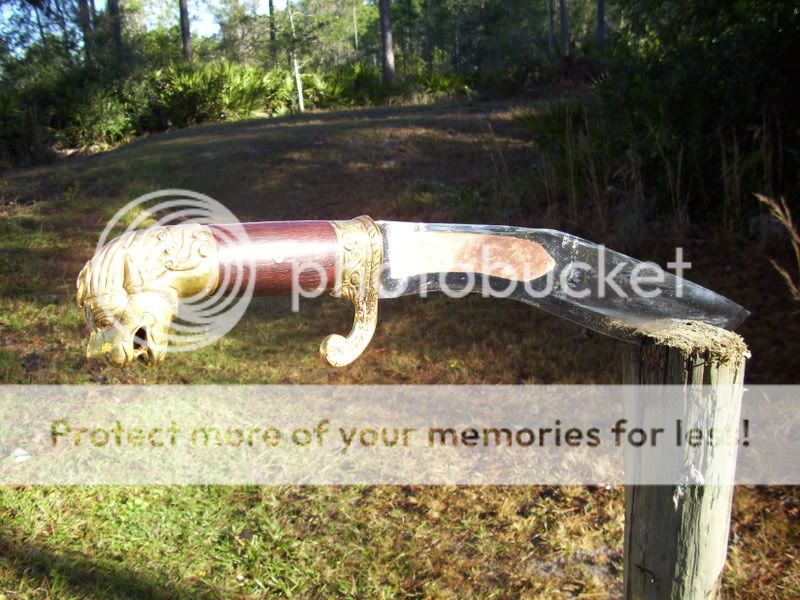- Joined
- Oct 25, 2004
- Messages
- 3,178
Not to pick on you, but I'm not sure about some of this.
I'm not sure what you're trying to say here. I have several swords made of similar steel at a spring temper and they have been misused spectacularly, but none of them "spring" when striking with the edge. A blade as wide as a khukuri (or sword) simply won't do that, no matter how hard you're swinging it.
A spring temper on the spine will not cause a blade to snap. Such a temper performs the exact opposite. It will still bend. It will probably require more force to bend it, in fact, and it will be able to bend a bit and still return to true afterward. In short, there would be no disadvantage at all to a spring-tempered spine and significant advantages added on. I disagree strongly that a blade with a hard edge and a spring temper on the spine is a bad idea. It's an excellent idea, and is probably what the kamis are shooting for as an ideal heat treat.
Sort of. You want a softer spine, not a soft one, and even that is incorrect. You want a "springy" one. The fact that softness is often a result of springiness is one that we must live with, but remember what we're looking for here. Springiness supports the hard edge, absorbs energy, and resists snapping or bending. Softness on its own is undesirable.
Again, I strongly disagree. Bending is indicative of an improper but basically acceptable heat treat. Ideally, it would have sprung back instead of taking a set.
That having been said, how many people are going to bend one, even heat treated like this? Very few, and they're going to have to work at it. Let's not try to make this sound like it's what we want, though, because it's not. True, we'd prefer it over brittleness, but I'd prefer a spring temper (in the spine) over either. Due to the nature of the kamis' heat treating process we won't get perfect ones every time, but we will get ones that are close enough for government work (like this one was) nearly every time. :thumbup:
Are any of those knives 3/8-1/2" Thick? Hell no. Of course those knives will "spring" back to shape... they're made of stamped sheet metal probably 3/32" thick... besides, do you really want a 2 pound piece of steel with a razor edge to be "springing" around after a forceful blow? Not only is it dangerous, but it has no feasible benefit whatsoever - a proper heat treat of a knife will allow it to bend (rather than snap) when subjected to high strain like in the video
I'm not sure what you're trying to say here. I have several swords made of similar steel at a spring temper and they have been misused spectacularly, but none of them "spring" when striking with the edge. A blade as wide as a khukuri (or sword) simply won't do that, no matter how hard you're swinging it.
A spring temper on the spine will not cause a blade to snap. Such a temper performs the exact opposite. It will still bend. It will probably require more force to bend it, in fact, and it will be able to bend a bit and still return to true afterward. In short, there would be no disadvantage at all to a spring-tempered spine and significant advantages added on. I disagree strongly that a blade with a hard edge and a spring temper on the spine is a bad idea. It's an excellent idea, and is probably what the kamis are shooting for as an ideal heat treat.
Read up on proper heat treating - specifically differential hardening. You want a soft spine and a hard (yet not brittle) edge on a hard impact blade... the hardened edge allows for a good cut while the soft spine allows the knife or sword to not shatter upon impact. Many famous blade styles have implemented this throughout history - most notably japanese katanas.
Sort of. You want a softer spine, not a soft one, and even that is incorrect. You want a "springy" one. The fact that softness is often a result of springiness is one that we must live with, but remember what we're looking for here. Springiness supports the hard edge, absorbs energy, and resists snapping or bending. Softness on its own is undesirable.
Again - none of those blades were 3/8-1/2" thick and the bending is indicative of a proper heat treat, not a lack of one.
Again, I strongly disagree. Bending is indicative of an improper but basically acceptable heat treat. Ideally, it would have sprung back instead of taking a set.
That having been said, how many people are going to bend one, even heat treated like this? Very few, and they're going to have to work at it. Let's not try to make this sound like it's what we want, though, because it's not. True, we'd prefer it over brittleness, but I'd prefer a spring temper (in the spine) over either. Due to the nature of the kamis' heat treating process we won't get perfect ones every time, but we will get ones that are close enough for government work (like this one was) nearly every time. :thumbup:









